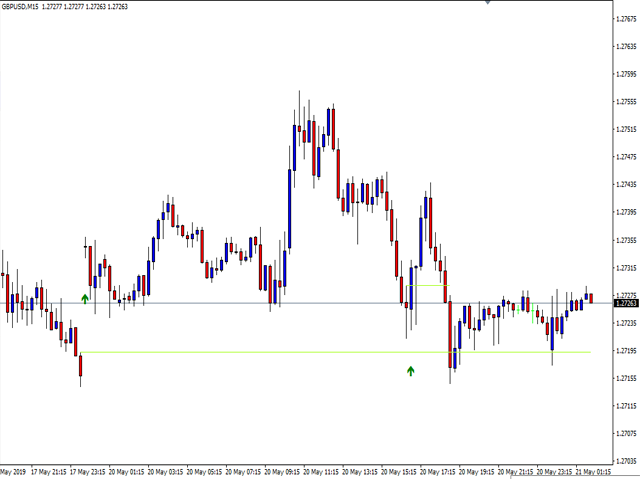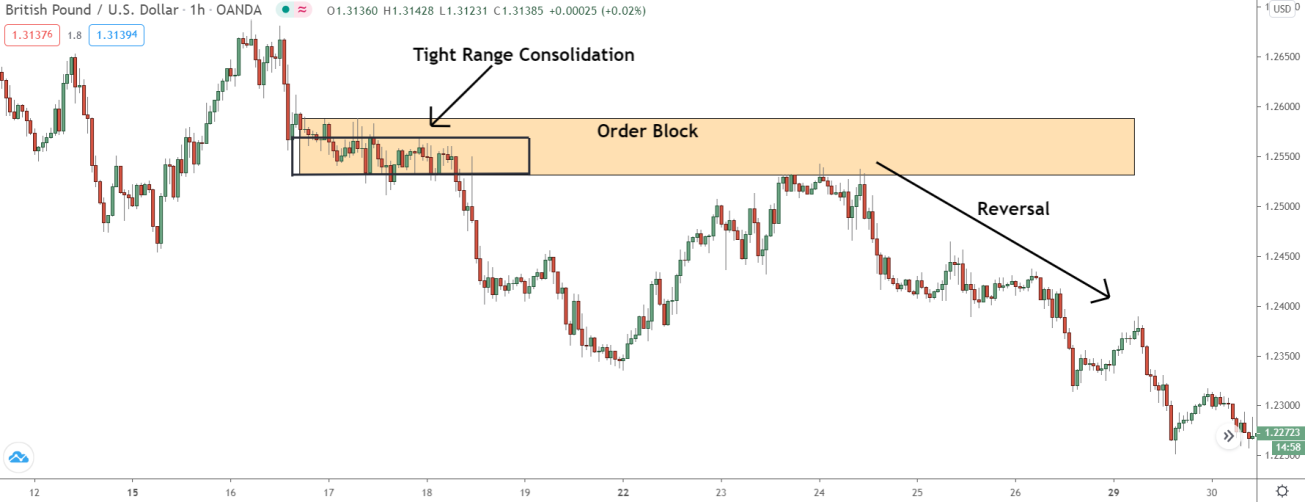
24/03/ · Extend this rectangle by how long you expect the price to continue being in this range. As a Rule of Thumb #3: for the Order Block to be valid, the price must not close below the middle of the Order Block Range as shown in the picture above. This applies to both Bearish Order Blocks and Bullish Order Blocks 25/04/ · Order blocks are a rare type of supply or demand zones, so trading order blocks and supply/demand zones are the same. Simply mark the zone on the chart. Wait for a Doji, engulfing bar, or large range bar to appear, and then place the stop loss on the other side of the bar. Look for the price to move away This creates the forex order block. Forex order blocks are often associated with the situation in which a large player builds their positions slow and steady and out of the public focus. This view is similar to the accumulation phase in the Wyckoff market cycle theory. In our opinion, people often overstate the importance of order blocks
Forex Order Blocks Explained (Basic Concept Walkthrough)
We wrote this guide with beginners in mind, so it is going to be super easy to understand. At the same time, we jam-packed it with useful insights so even more experienced traders will find it interesting.
Note: Order blocks was popularized by the Inner Circle Trader YouTube channel as ICT order blocks. This is not an article about ICT and his methods. Rather, it is our attempt to give you an explanation for order blocks in general. You can find so much information and different theories on forex order blocks that they might look super complicated. An order block is a zone on your chart that forms when someone is conducting large-scale buying or selling. Large traders such as banks and institutions tend to fear that if others see them executing a large buy or sell program, their intentions will become public and prices will move against them.
Thus, they will try to discreetly arrange large trades out of the public eye. Often these orders will be located at around the same level so when they get executed, they will create a sideways range on the chart. This creates the forex order block, how to identify order blocks in forex. Forex order blocks are often associated with the situation in which a large player builds their positions slow and steady and out of the public focus. This view is similar to the accumulation phase in the Wyckoff market cycle theory.
In our opinion, people often overstate the importance of order blocks. They exist because large orders are typically impractical to execute at one go. They do not necessarily mean market manipulation.
The sell order for the 1 billion EUR from the previous example might come from an American company wanting to repatriate their European profits. Both of these will result in a worse selling price for the company.
Thus, it will naturally go the extra mile to ensure the trade gets executed with a minimal footprint and at a great how to identify order blocks in forex. One simple thing the company can do is to leave a reoccurring sell order at 1.
So, other traders will see a sell limit for million EUR at 1. This will continue until the whole 1 billion position is sold out. Of course, there are many other creative methods for executing large orders. The point is that while these methods are designed to conceal institutional activity, they are often not there to hurt you.
The truth is that while you can find interesting set-ups, you never know for sure if it is an order box unless you are tipped off by someone or you are the one executing the order. Simply draw a rectangle that contains the horizontal level from which the price keeps rebounding, and the accompanying market structure. This is where a potential forex order block might be located.
This content belongs to Forexspringboard. Do not copy without permission. Essentially you need to find situations where the market is in a narrow range and the price keeps turning around at a specific level.
You might see these areas better using lower timeframes. The difference is that many important support and resistance levels cover a long time period where touches are spaced away months or even years.
Order blocks, on the other hand, relate to short-term price action. Any exchange rate above this level was considered to be unacceptable Forint weakness for many market participants including the central bank so the demand for forints around this area was high. This created a clearly visible resistance area on the chart, which was only broken after war in Ukraine put significant pressure on regional currencies. Even then, the price came back to retest the level.
The market seemingly bottomed out at 1. When the order was finally filled the resistance disappeared and the price slowly began to take off. We encourage you to look at a few low-level charts and see how they behave especially when the London and New York markets are closed.
You will easily how to identify order blocks in forex many similar scenarios. Researchers from The Tinbergen Institute a joint institute for the University of Amsterdam did an interesting study in which they investigated the behavior of high-frequency traders when a large institutional order executes through a series of child trades.
Inspired by other theoretical studies, they highlight the three primary ways order blocks can be approached by traders:.
So, when you supply liquidity in the context of forex order blocks, it basically means that you sell when the institution buys and buy when the institution sells. Say you went long at the close of the pin bar candlestick pattern highlighted. You placed your stop loss slightly below the pin bar, which is normal practice. You expected the market to rise after lower prices had been rejected.
Instead, the next candle was a huge bearish candlestick. The price dipped below your entry point and triggered an institutional buy and stopped you out the same time. Since being long means that you had bought the currency pair, the moment your stop was triggered, you were forced to sell to close the position.
While this is rarely desired, it occurs from time to time. You might try to use wider stop losses or learn how to trade fakeouts. Reading the previous section how to identify order blocks in forex left you wondering why to go against the huge bullish candle when you can ride the wave — even if it is only transitory. You can see from the picture above that each time the floor was tested it held successfully as the central bank could simply print more francs and sell them for euros to protect the floor.
Many traders figured that buying the EURCHF every time it gets close to 1. It brings together real-time data on every market, breaking news, in-depth research, analytics, communications tools and much more — in one fully integrated solution.
By Travis Wise, how to identify order blocks in forex. We promise this is not an ad for the terminal. It just goes to illustrate that institutions are equipped with better information that retail traders. Then you simply trade along with the institution, how to identify order blocks in forex. But nothing is easy in trading. And if you see that, for example, someone is buying heavily before an important news release, why not speculate on the possibility that they might know something?
Lots of people talk about forex order blocks on the internet, many of them will give you wrong expectations. Order blocks do exist, but you never know for sure if what you are seeing is a true order block or just the market randomly consolidating. You still need to time your trade properly, take profits at the right time and manage your risks. All these make it difficult to profit from even great insights. Stay open to learning new things and broadening your understanding of the market but try to steer clear from empty promises of easy money and different conspiracy theories.
What is a Forex Order Block? We want to keep it simple. Forex Flag Patterns: A Simple Guide to Understand Them. Drop Base Rally and Rally Base Drop Made Simple [Bonus Strategy]. Want the inside scoop? JOIN THE COMMUNITY. Subscribe to get Forex how to identify order blocks in forex materials delivered to your inbox once a week. Send me great stuff Join the Community By subscribing we will send you education emails about Forex trading.
Please select all the other ways you would like to hear about us: Yes please, send me updates, eg. new blog posts. Yes please, send me offers about trading related products and services.
We won't send you spam. Unsubscribe at any time. Legal Terms and Conditions Privacy and Cookie Policy Cookie Declaration Page About. Trading FX or CFDs on leverage is high risk and your losses could exceed deposits. Any advice or information on this how to identify order blocks in forex is written exclusively for educational purposes, how to identify order blocks in forex.
It does not contain recommendations or calls for the purchase, sale or storage of any financial instruments.
All rights Reserved under US and international law.
ORDERBLOCKS: Everything You Need To Know About Order Blocks Simplifed!
, time: 21:56How To Identify Order Block In Forex

21/05/ · This video explain explicitly on Order Blocks, explaining how to identify the weak Order Block from the Strong Order Block. Also, it explains another rejecti Author: Liquidity Providers Concepts 31/07/ · Order block is a market behavior that indicates order collection from financial institutions and banks. Prominent financial institutes and central banks drive the forex market. Therefore, traders must know what they are doing in the market. When the market builds the order block, it moves like a range where most of the investing decisions happen 24/03/ · Extend this rectangle by how long you expect the price to continue being in this range. As a Rule of Thumb #3: for the Order Block to be valid, the price must not close below the middle of the Order Block Range as shown in the picture above. This applies to both Bearish Order Blocks and Bullish Order Blocks
No comments:
Post a Comment